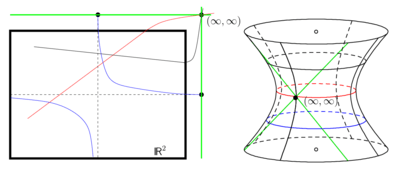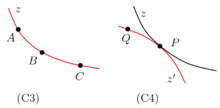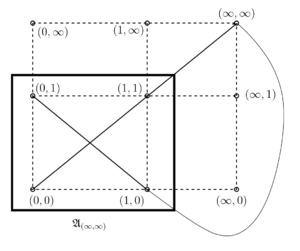Minkowski plane
In mathematics, a Minkowski plane (named after Hermann Minkowski) is one of the Benz planes: Möbius plane, Laguerre plane and Minkowski plane.
The classical real Minkowski plane

Applying the pseudo-euclidean distance  on two points
on two points  (instead of the euclidean one) we get the geometry of hyperbolas, because a pseudoeuclidean circle
(instead of the euclidean one) we get the geometry of hyperbolas, because a pseudoeuclidean circle  is a hyperbola with midpoint
is a hyperbola with midpoint  . By a suitable coordinate transformation we can
rewrite the pseudo-euclidean distance as
. By a suitable coordinate transformation we can
rewrite the pseudo-euclidean distance as  . Now the hyperbolas have asymptotes parallel to the coordinate axes. The following completion (see Möbius and Laguerre planes) homogenizes the geometry of hyperbolas:
. Now the hyperbolas have asymptotes parallel to the coordinate axes. The following completion (see Möbius and Laguerre planes) homogenizes the geometry of hyperbolas:
-
 , the set of points,
, the set of points, -

-
 the set of cycles.
the set of cycles.
-
The incidence structure  is called classical real Minkowski plane.
is called classical real Minkowski plane.
The set of points consists of  and two copies of
and two copies of  and point
and point  .
.
Any line  is completed by point
is completed by point  , any hyperbola
, any hyperbola
 by the two points
by the two points  (see figure).
(see figure).
Two points  can not be connected by a cycle if and only if
can not be connected by a cycle if and only if
 or
or  . We define:
. We define:
Two points  are (+)-parallel (
are (+)-parallel ( ) if
) if  and (-)-parallel (
and (-)-parallel ( ) if
) if  .
.
Both these relations are equivalence relations on the set of points.
Two points  are called parallel (
are called parallel ( ) if
) if
 or
or  .
.
From the definition above we find:
Lemma:
- For any pair of non parallel points
 there is exactly one point
there is exactly one point  with
with  .
. - For any point
 and any cycle
and any cycle  there are exactly two points
there are exactly two points  with
with  .
. - For any three points
 , pairwise non parallel, there is exactly one cycle
, pairwise non parallel, there is exactly one cycle  which contains
which contains  .
. - For any cycle
 , any point
, any point  and any point
and any point  and
and  there exists exactly one cycle
there exists exactly one cycle  such that
such that  , i.e.
, i.e.  touches
touches  at point P.
at point P.
- For any pair of non parallel points
Like the classical Möbius and Laguerre planes Minkowski planes can be described as the geometry of plane sections of a suitable quadric. But in this case the quadric lives in projective 3-space: The classical real Minkowski plane is isomorphic to the geometry of plane sections of a hyperboloid of one sheet (not degenerated quadric of index 2).
The axioms of a Minkowski plane
Let be  an incidence structure with the set
an incidence structure with the set  of points, the set
of points, the set
 of cycles and two equivalence relations
of cycles and two equivalence relations  ((+)-parallel) and
((+)-parallel) and  ((-)-parallel) on set
((-)-parallel) on set  .
For
.
For  we define:
we define:
 and
and
 .
An equivalence class
.
An equivalence class  or
or  is called (+)-generator
and (-)-generator, respectively. (For the space model of the classical Minkowski plane a generator is a line on the hyperboloid.)
is called (+)-generator
and (-)-generator, respectively. (For the space model of the classical Minkowski plane a generator is a line on the hyperboloid.)
Two points  are called parallel (
are called parallel ( ) if
) if  or
or  .
.
An incidence structure  is called Minkowski plane if the following axioms hold:
is called Minkowski plane if the following axioms hold:


- C1: For any pair of non parallel points
 there is exactly one point
there is exactly one point  with
with  .
. - C2: For any point
 and any cycle
and any cycle  there are exactly two points
there are exactly two points  with
with  .
. - C3: For any three points
 , pairwise non parallel, there is exactly one cycle
, pairwise non parallel, there is exactly one cycle  which contains
which contains  .
. - C4: For any cycle
 , any point
, any point  and any point
and any point  and
and  there exists exactly one cycle
there exists exactly one cycle  such that
such that  , i.e.
, i.e.  touches
touches  at point P.
at point P. - C5: Any cycle contains at least 3 points. There is at least one cycle
 and a point
and a point  not in
not in  .
.
For investigations the following statements on parallel classes (equivalent to C1, C2 respectively) are advantageous.
- C1': For any two points
 we have
we have  .
. - C2': For any point
 and any cycle
and any cycle  we have:
we have:  .
.
First consequences of the axioms are
Lemma: For a Minkowski plane  the following is true
the following is true
- a) Any point is contained in at least one cycle.
- b) Any generator contains at least 3 points.
- c) Two points can be connected by a cycle if and only if they are non parallel.
Analogously to Möbius and Laguerre planes we get the connection to the linear geometry via the residues.
For a Minkowski plane  and
and  we define the local structure
we define the local structure
and call it the residue at point P.
For the classical Minkowski plane  is the real affine plane
is the real affine plane  .
.
An immediate consequence of axioms C1 - C4 and C1', C2' are the following two theorems.
Theorem: For a Minkowski plane  any residue is an affine plane.
any residue is an affine plane.
Theorem:
Let be  an incidence structure with two equivalence relations
an incidence structure with two equivalence relations  and
and  on the set
on the set  of points (see above).
of points (see above).
 is a Minkowski plane if and only if for any point
is a Minkowski plane if and only if for any point  the residue
the residue  is an affine plane.
is an affine plane.
The minimal model of a Minkowski plane can be established over the set
 of three elements:
of three elements:
-
 ,
, -
 if and only if
if and only if  and
and  if and only if
if and only if  .
.
Hence:  and
and  .
.

For finite Minkowski-planes we get from C1', C2':
Lemma:
Let be  a finite Minkowski plane, i.e.
a finite Minkowski plane, i.e.  . For any pair
of cycles
. For any pair
of cycles  and any pair of generators
and any pair of generators  we have:
we have:
 .
.
This gives rise of the definition:
For a finite Minkowski plane  and a cycle
and a cycle  of
of  we call the integer
we call the integer  the order of
the order of  .
.
Simple combinatorial considerations yield
Lemma:
For a finite Minkowski plane  the following is true:
the following is true:
- a) Any residue (affine plane) has order
 .
. - b)
 , c)
, c)  .
.
Miquelian Minkowski planes
We get the most important examples of Minkowski planes by generalizing the classical real model: Just replace  by an arbitrary field
by an arbitrary field  then we get in any case a Minkowski plane
then we get in any case a Minkowski plane  .
.
Analogously to Möbius and Laguerre planes the Theorem of Miquel is a characteristic property of a Minkowski plane  .
.

Theorem (MIQUEL): For the Minkowski plane  the following is true:
the following is true:
- If for any 8 pairwise not parallel points
 which can be assigned to the vertices of a cube such that the points in 5 faces correspond to concyclical quadruples than the sixth quadruple of points is concyclical, too.
which can be assigned to the vertices of a cube such that the points in 5 faces correspond to concyclical quadruples than the sixth quadruple of points is concyclical, too.
(For a better overview in the figure there are circles drawn instead of hyperbolas.)
Theorem (CHEN): Only a Minkowski plane  satisfies the theorem of Miquel.
satisfies the theorem of Miquel.
Because of the last theorem  is called a miquelian Minkowski plane.
is called a miquelian Minkowski plane.
Remark: The minimal model of a Minkowski plane is miquelian.
- It is isomorphic to the Minkowski plane
 with
with  (field
(field  ).
).
An astonishing result is
Theorem (Heise): Any Minkowski plane of even order is miquelian.
Remark: A suitable stereographic projection shows:  is isomorphic
to the geometry of the plane sections on a hyperboloid of one sheet (quadric of index 2) in projective 3-space over field
is isomorphic
to the geometry of the plane sections on a hyperboloid of one sheet (quadric of index 2) in projective 3-space over field  .
.
Remark: There are a lot of Minkowski planes which are not miquelian (s. weblink below). But there are no "ovoidal Minkowski" planes, in difference to Möbius and Laguerre planes. Because any quadratic set of index 2 in projective 3-space is a quadric (see quadratic set).
References
- W. Benz, Vorlesungen über Geomerie der Algebren, Springer (1973)
- F. Buekenhout (ed.), Handbook of Incidence Geometry, Elsevier (1995) ISBN 0-444-88355-X
